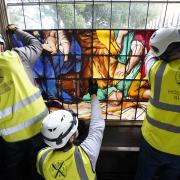In 2019 it was the 200th anniversary of Keats’ visit to Winchester, that stay of 1819 sadly only a relatively short while before his demise, but also one of immense importance as it inspired one of his most famous and beloved poems, To Autumn; ‘season of mists and mellow fruitfulness’. Winchester has that effect on people. As we head into the autumn season maybe it’s time to revisit Winchester and find out what it is about the cathedral city that so inspired Keats during the late summer and early autumn of that year. His daily yomp was through the Cathedral Close and water meadows to St Cross. One likes to feel the walk Keats enjoyed hasn’t changed much and that he’d feel at home if he could tread that way again. Today’s ‘Keats’ Walk’, a round trip, is around two miles afoot pavement, grass and gravel path.
The son of a livery-stable keeper, it seemed Keats was destined for a career in medicine, but he was fixated on the arts, having artistic friends, a liking for Mozart and a love of poetry which saw his first sonnets published in Leigh Hunt’s Examiner in 1816. Hunt (1784-1859) was a poet and essayist who’d recently spent a couple of years in prison for libelling the prince Regent. Keats’ first volume of poems came out in 1817 whilst his mythological poem Endymion followed the year after.
Keats managed a walking tour to the Lake District and Scotland in July 1818 with his pal Charles Armitage Brown (1787-1842); he liked his walking. His yomp around those northern parts did leave him close to exhaustion, however, and he probably felt more fatigued when he returned to unfavourable reviews of Endymion. Rather quaintly he regarded his trip to Scotland as his first ‘abroad’. Not everything was well in Keats’ world though. He had a younger brother, Tom, dying of consumption, and love wasn’t running smoothly for him either, his affair with Fanny Brawne adding to his travails. An early ode, Ode to Maia, was also written in 1818.
We don’t know where Keats lodged in 1819 when he came to Winchester with his closest friend, Brown, but we know he took ‘a walk every day for an hour before dinner’.
Nowadays, Keats’ Walk starts at the Info Centre in the Guildhall, close to King Alfred’s statue, then heads up the High Street and into Market Street to attain the cathedral where Keats wandered the North Aisle where Jane Austen was buried just two years before, his mind preoccupied as he read letters from Fanny.

How Keats must have marvelled at the cathedral’s ‘beautiful front’. Walking beneath stone arches takes us through the Inner Close which Keats described as ‘two college-like squares seemingly built for the dwelling place of Deans and Prebendaries – garnished with grass and shaded with trees’ and along to Cheyney Court, one of the city’s most photogenic buildings, formerly the Bishop’s courthouse.


St Swithun’s Gate takes us from the Inner Close to Kingsgate, one of only two surviving city gates with the miniscule church of St Swithun-upon-Kingsgate atop. Heading under Kingsgate we follow College Street where number 8 is the house of Jane Austen’s last few weeks where she finished Persuasion. Keats wouldn’t have benefited from the plaque but would have known of the authoress’ demise.

He was now in an area dominated by Winchester College, founded in 1382 and England’s longest continually operating public school, and at the end of College Street he would have found the ruins of Wolvesey Castle, or the Old Bishop’s Palace, the onetime residence of the Bishops of Winchester, which was abandoned in favour of a new palace, Wolvesey, built next door in the 1680s. All this would have been evident to Keats.
A turn into College Walk and a jaunt across the College car park picks up the path through the water meadows. It’s a bucolic scene as one follows Keats’ footsteps by the side of a chalk stream of the Itchen, all moorhen, trout, and wildflowers. The angler-dangler Isaak Walton (1593-1683) fished the Itchen; he’s also buried in the cathedral.

St Catherine’s Hill lies ahead. A crossing of Garnier Road eventually brings us to the Hospital of St Cross which Keats described as ‘a very interesting old place, both for its gothic tower and alms-square, and for the appropriation of its rich rents to a relation of the Bishop of Winchester’ where he raked up a contemporary corruption scandal which later inspired an Anthony Trollope novel.

The hospital, founded in 1136, is famous of course for its Wayfarer’s Dole, bread, and ale, as well as being the country’s oldest charitable institution. Keats’ final comments on what he’d seen were to ‘pass across St Cross meadows till you come to the most beautifully clear river’ and ‘there is on one side of the city a dry chalky down where the air is worth sixpence a pint’. Quite. We know Keats left Winchester in early October by which time he had To Autumn in his pocket.
It would be after Winchester that Keats’ Lamia and Other Poems came out (in 1820) although with a couple of exceptions all the significant verse in this famous volume was his work of 1819 so it’s not too fanciful to think he was mentally composing whilst walking those Winchester streets especially as To Autumn, dating to September 19, 1819, is one of the odes illuminating the book.
Other 1819 contributions include the wonderful romances The Eve of St Agnes and that of the title, Lamia, the great odes On a Grecian Urn, To a Nightingale, On Melancholy and To Psyche.
Keats was seriously ill with consumption himself, sailed for Italy in September 1820, and died in Rome on February 23, 1821. He was just 25.
Keats was gone too young, but we still have To Autumn that he left for us, wistful memories of his Winchester walk:
‘And full-grown lambs loud bleat from hilly bourne;
Hedge-crickets sing;
and now with treble soft The redbreast whistles from a garden-croft;
And gathering swallows twitter in the skies’.



























